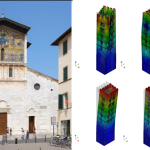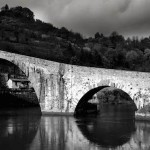Structural health monitoring of historic buildings via wireless sensor networks and numerical tools

Coordinator: ISTI-CNR
Partners: ISTI-CNR (Mechanics of Materials and Structures Laboratory and Wireless Networks Laboratory)
Project website: http://monster.isti.cnr.it
Contact: Maria Girardi
Keywords: masonry buildings, operational modal analysis, dynamic identification, numerical codes, monitoring, wireless sensors.
The project aims at developing an integrated monitoring and simulation framework for the structural health control of ancient masonry constructions. Sensing is based on small, inexpensive and interconnected wireless devices, developed by the Wireless Network Lab of ISTI-CNR. The data produced become the input for numerical simulations based on the NOSA-ITACA code, a finite-element software developed by the Mechanics of Materials and Structures Lab of ISTI-CNR to simulate the static and dynamic behaviour of masonry buildings, while taking into account the effects of cracking. The project’s activities include some laboratory tests on the prototypes and the installation of a wireless accelerometer network on the San Frediano bell tower in Lucca.
http://www.cnrweb.tv/arriva-monster-ecco-il-monitoraggio-degli-edifici-storici/
Applications
- The bell tower of the San Frediano church – Lucca

The Basilica of San Frediano, dating back to the eleventh century, is one of the most fascinating monuments in Lucca, much of its fascination being due to the marvellous mosaics that adorn its façade. During the MONSTER project the bell tower has been fitted by a sensor network able to measure its vibrations during the day. In particular, some low cost accelerometers, developed by the Wireless Networks Lab of ISTI-CNR, have been installed, able to measure the most relevant vibrations of the tower, induced by the swinging of the bells or the traffic in the most busy hours. This instrumentation has been coupled with four high sensitivity seismic stations, made available by the Seismic Observatory of Arezzo (INGV), in order to catch the tower’s smallest movements. Some temperature and humidity sensors integrated the network.
Data coming from the monitorin system have been analysed via some dynamic identification procedures, such as the Stochastic Subspace Identification and the Enhanced Frequency Domain Decomposition method. Finally, a finite-element model of the tower has been created via the NOSA-ITACA code, updated to fit the experimental data and then used to simulate the tower’s response to static and dynamc actions.
Continua la lettura → - The Maddalena bridge – Borgo a Mozzano (LU)

This very famous and fascinating structure dates back to the eleventh century and has a total length of about 100 m. It is made up of four semicircular arches, the greatest of which has a clear span of 38 m. The bridge, whose piers are immersed in an artificial basin created by the water of the Serchio River, hosts in its right abutment the railway connecting Lucca with the Appennine passes. During the MONSTER project, the bridge has been instrumented with four high-sensitivity triaxial seismometric stations, made available by the Seismic Observatory of Arezzo (INGV), left active on the bridge for about 8 hours, on the 16th of June, 2015. The sensors were moved in different positions on the bridge’s deck, in order to improve the description of the mode shapes. Data coming from the monitoring system have been analysed via the Stochastic Subspace Identification and the Enhanced Frequency Domain Decomposition methods. Finally, a finite-element model of the bridge has been created via the NOSA-ITACA code and updated to fit the experimental data. Dynamic analyses of the bridge’s response under the self weight and during the transit of a cargo train have been performed, by applying to the model an acceleration time-history recorded on the railway in June 2006.
Continua la lettura →


